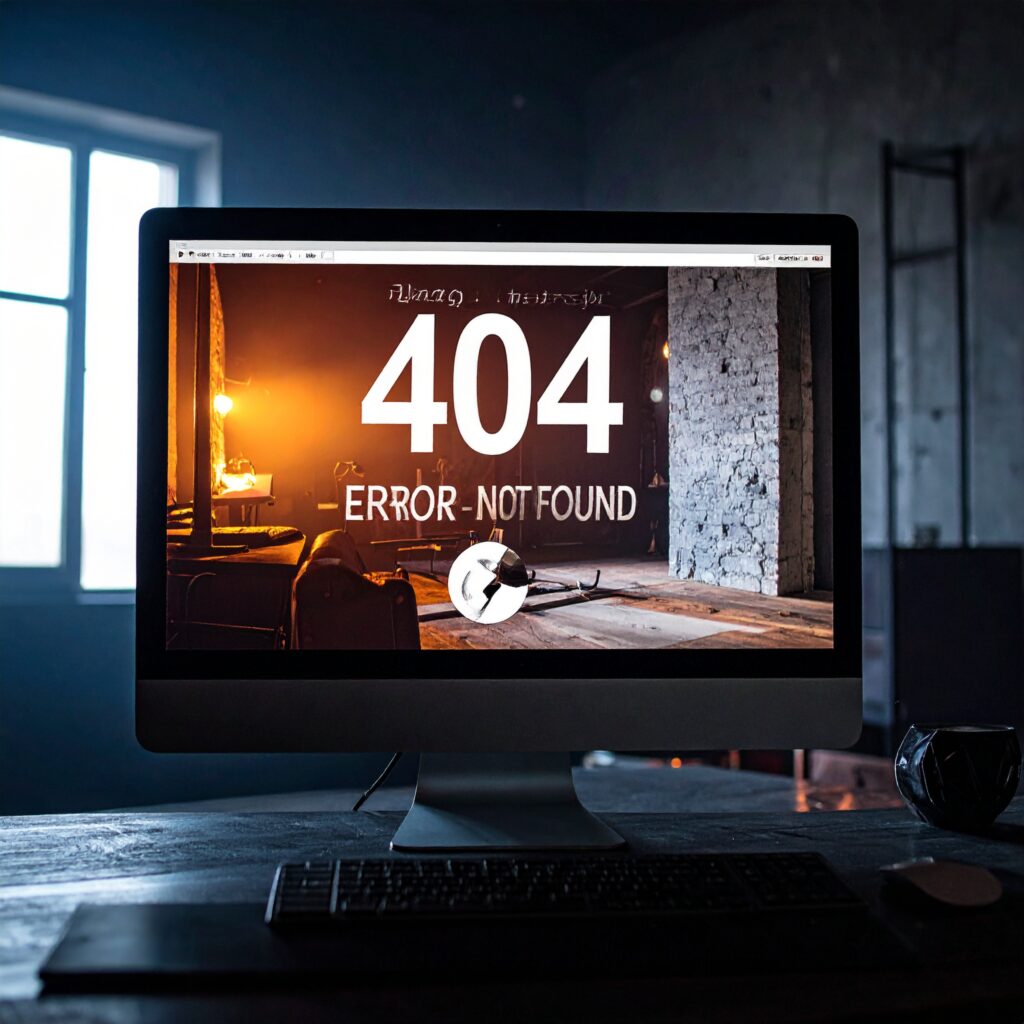The 404 error code is a standardized HTTP status code sent from a web server to a browser, indicating that the requested page or resource is not available. Users often encounter phrases like ‘Page Not Found’ or ‘404 – File Not Found’ when this error occurs. This client error response has significant implications for web browsing:
- It signifies that the server cannot find the requested webpage, leading to a dead end for users.
- Users may see messages like ‘Page Not Found,’ conveying the unavailability of the desired content.
- 404 errors can result in a loss of visitors and decreased trustworthiness for websites, affecting their reputation negatively.
This error disrupts the seamless browsing experience and can have detrimental effects on both user engagement and website credibility.
Causes and Consequences of 404 Errors
Causes of 404 Errors
There are several reasons why 404 errors occur on websites:
- Removed Content: When a webpage or resource is deleted without setting up a proper redirect, visitors trying to access that page will encounter a 404 error.
- Deleted URLs: If the URL structure of a website changes and old URLs are not redirected to their new counterparts, users and search engines will encounter broken links.
- Server Issues: Temporary server problems or misconfigurations can lead to 404 errors if the server fails to serve requested pages.
- DNS Failures: Domain Name System (DNS) issues can prevent browsers from resolving domain names, resulting in 404 errors when users try to access the site.
Consequences of Broken Links
Broken links have several negative consequences for websites:
- Frustrated Users: When users click on a link and land on a non-existent page, it creates frustration and dissatisfaction with the website experience.
- Search Engine Crawling Issues: Search engines rely on links to discover and index web pages. If there are too many broken links on a site, it can hinder search engine crawlers from effectively navigating and indexing the content.
- Loss of Traffic: If important pages on a website have broken links, it can result in lost traffic as users are unable to access those pages.
- Negative Impact on SEO: Search engines may view broken links as a sign of poor website quality or neglect, which can negatively impact search rankings.
The Impact of 404 Errors on SEO Performance
Search engines like Google prioritize user experience, and part of that involves ensuring that websites are functioning properly. When search engine crawlers encounter a high number of 404 errors on a website, it can signal that the site is not well-maintained or that there are issues with its structure.
Potential Consequences of 404 Errors on SEO
Here are some potential consequences of having a significant number of 404 errors on your website:
- Search Engine Penalties: While it’s unlikely that search engines will impose strict penalties solely for having 404 errors, consistently encountering broken links may lead to a decrease in trustworthiness in the eyes of search engines.
- Lower Search Result Placement: If search engines perceive your website as unreliable due to frequent 404 errors, it may impact your rankings and result in lower placement in search results.
- Indexing Issues: Search engines rely on crawling and indexing to understand the content of your website. If important pages are returning 404 errors, it can hinder their ability to index those pages correctly.
The Importance of Fixing 404 Errors for SEO
To maintain optimal SEO performance, it’s crucial to address 404 errors promptly. Here’s why:
- User Experience: Broken links can frustrate users and lead to a negative experience on your website. By fixing these errors, you can provide a seamless browsing experience and keep visitors engaged.
- Crawlability: Search engine crawlers visit websites to discover and index new content. If they encounter multiple 404 errors during their visit, it may result in them skipping over important pages or deeming your site less relevant.
- Link Equity: If other websites are linking to pages on your site that return 404 errors, you may be missing out on valuable link equity. Fixing these broken links can help preserve the authority and ranking power of those pages.
By proactively monitoring and fixing 404 errors, you can mitigate potential SEO issues and ensure that your website remains search engine friendly.
Detecting and Resolving 404 Errors: A Step-by-Step Guide
Identifying 404 errors on your website is crucial for maintaining its health and user satisfaction. Several tools simplify this task by scanning your site for broken links and reporting instances of the 404 error code.
Key Tools to Detect 404 Errors
1. Google Search Console
A free service by Google that provides detailed reports on site performance, including crawl errors like 404s. It helps you understand which pages are unreachable by Googlebot.
2. Dead Link Checker
An easy-to-use online tool that scans your entire website, highlighting dead or broken links that return 404 errors. Useful for quick checks without complex setup.
3. W3C Link Checker
Provided by the World Wide Web Consortium, this tool validates links on any webpage, identifying broken URLs with precision. Ideal for thorough link audits.
How to Use These Tools Effectively
1. Google Search Console
- Sign in and select your website property.
- Navigate to the “Coverage” report under the “Index” section.
- Look for errors labeled as “Not Found (404).”
- Click each error to see affected URLs and troubleshoot accordingly.
2. Dead Link Checker
- Enter your website URL on the tool’s homepage.
- Start a scan to list all broken links detected across your site pages.
- Export the results to prioritize fixing based on severity or page importance.
3. W3C Link Checker
- Input the URL of a specific page or entire site directory.
- Customize options such as recursive checking or ignoring certain file types if needed.
- Review the generated report showing all invalid links triggering 404 errors.
These tools give you actionable insights into where 404 error codes appear, enabling focused fixes that improve both user experience and search engine indexing efficiency.
Fixing Strategies for Different Types of 404 Errors
Addressing 404 errors requires tailored strategies depending on the cause. Here are key approaches you can apply:
1. Correct URL Typos
Many 404 errors occur due to simple typing mistakes in the URL. Carefully review the address for misspellings, missing characters, or incorrect domain extensions. Encourage users to double-check URLs or use autocomplete features in browsers to minimize these errors.
2. Implement Proper Redirects
When pages are moved or deleted, set up 301 redirects from the old URLs to relevant new pages. This ensures visitors and search engines find the correct content without hitting broken links. Use server configuration files like .htaccess for Apache or URL rewrite rules in Nginx to manage redirects efficiently.
3. Page Reloads and Cache Clearing
Sometimes a temporary glitch causes a page not to load correctly. Advising users to reload the page or clear their browser cache can resolve transient 404 errors caused by outdated cached data.
4. Improve Site Navigation
Provide clear navigation paths such as menus, breadcrumbs, and site search options. Users who land on a 404 page can then easily find related content or return to main sections of your website instead of leaving frustrated.
Applying these fixes reduces broken link issues, enhances user experience, and helps maintain your site’s credibility and SEO health.
Enhancing User Experience with Customized 404 Error Pages
Creating custom error pages offers significant benefits in enhancing user experience on your website. Instead of displaying a generic ‘Page Not Found’ message, customized error pages can provide users with valuable information and alternative navigation options to keep them engaged.
Mitigating User Frustration
When users encounter a 404 error, it can lead to frustration and confusion. By designing custom error pages that align with your website’s style and branding, you can effectively mitigate user frustration and maintain a positive user experience.
Helpful Navigation Options
Custom error pages can include helpful navigation elements such as site maps, search boxes, related links, or a direct link back to the homepage. These features empower users to continue exploring your website even after encountering a broken link.
CMS Default Pages
Content management systems like WordPress, Joomla, and Drupal often generate default 404 pages automatically. While these default pages serve as a fallback option, creating personalized error pages allows you to tailor the messaging and design to better suit your audience.
By investing time and effort in crafting customized 404 error pages, you not only improve user satisfaction but also demonstrate your commitment to providing a seamless browsing experience for all visitors to your site.
Maintaining a Healthy Website: Best Practices for Preventing and Managing 404 Errors
Addressing the 404 error code is critical for good user experience and SEO performance maintenance. Broken links frustrate visitors and signal search engines that your site lacks upkeep. You can prevent and manage these errors by:
- Regularly scanning your website for broken links using tools like Google Search Console.
- Implementing proper redirects when moving or deleting content.
- Keeping URLs consistent and avoiding unnecessary changes.
- Creating clear navigation structures to minimize dead-end pages.
Take control of your site’s health by monitoring broken links actively. Proactive maintenance keeps users engaged and protects your SEO rankings from unnecessary harm.



